An Overview of Intelligent Transportation Systems in Europe
Abstract
1. Introduction
1.1. The Necessity of the Proposed Topic
1.2. Contribution to Current Research
1.3. Structure of the Paper
- -
- To examine the historical evolution of Intelligent Transport Systems (ITSs) and assess the impact of Directive 2010/40/EU on the European legislative framework, with a focus on how regulations and policies have supported ITS implementation;
- -
- To identify the essential components of ITSs and analyze their role in optimizing transport, particularly technologies such as automation, artificial intelligence (AI) and vehicle-to-infrastructure (V2I) communications;
- -
- To analyze the main European initiatives that support ITS development and evaluate their influence on road safety, urban mobility and environmental sustainability;
- -
- To investigate the obstacles and challenges in ITS implementation, including technical, legislative and economic issues, based on relevant case studies that highlight successful practices and lessons learned;
- -
- To explore future trends and development plans for ITSs in Europe, and to propose recommendations for improving the efficiency and interoperability of systems to support digitalization and sustainability goals.
2. A Brief History of ITSs in Europe
3. Key Components of Intelligent Transportation Systems
- -
- Sensors, cameras and traffic signals: Due to road conditions, vehicle movement and traffic flows, cameras and sensors collect data in real time. Smart traffic signals with GPS technology reduce congestion and manage dynamic traffic.
- -
- IoT transportation devices: Road units, sensors, detection cameras and traffic light control devices are just a few of the IoT technologies that are widely used in ITSs. These devices are vital for traffic control systems and route optimization, as they collect real-time data on weather conditions and road traffic flow.
- -
- Vehicle detection systems are aimed at tracking vehicles in critical areas using technologies such as electronic beacons, automatic license plate recognition and magnetic signature detection. Automatic incident detection and the monitoring of traffic flows at intersections and checkpoints require these software components of ITSs.
- -
- ITS software processes and analyses data collected by hardware components, enabling real-time decision-making and the efficient management of road traffic. Road traffic management software enables the control of vehicle flows, optimization of routes and reductions in environmental impacts. They help with vehicle-to-everything (v2x) communication and adaptive traffic light control, respectively [6].
- -
- Platforms that enable data analysis: By processing and interpreting data collected from traffic, data analysis platforms improve vehicle flows, increase safety and reduce environmental impact. These platforms help transport management to optimize road infrastructure [15].
- -
- High-definition (HD) maps, which provide accurate and up-to-date geospatial data, are another vital part of ITSs. They are essential for autonomous driving, traffic control and vehicle-to-vehicle (V2X) communication. Currently, in Europe, a number of applications, including HERE HD Live Map and TomTom’s HD Map platform, are used to facilitate the localization and decision-making processes for autonomous vehicles. Compared to traditional maps, HD maps provide centimeter-level accuracy in identifying road geometry, traffic signs, lane markings and static objects [18]. In order to support level 4–5 autonomous systems and complex traffic management approaches, the integration of HD maps into ITS infrastructures is becoming increasingly important.
4. Use of ITSs in Europe
4.1. Major ITS Initiatives
- -
- Battery 2030+, which is an effort to position Europe as a leader in battery technology by developing high-performance, safe and sustainable batteries. Efficient batteries are essential for electric vehicles and cleaner economies.
- -
- Graphene flagship, which reflects Europe’s commitment to improving materials science, exploring the applicability of graphene in various transport applications, such as sensors and lightweight materials for vehicles.
- -
- Social challenges and innovation in ITSs: Addressing societal challenges such as sustainable mobility and social inclusion is closely related to the implementation of ITSs. Projects funded through the European Union’s Horizon 2020 program emphasize that transport solutions should be easy to use and accessible to everyone, regardless of age, gender or social status [21]. The incorporation of social innovations into ITSs underlines the European Union’s commitment to developing a transport system that meets the needs of all users, facilitating the mobility of people with disabilities and those belonging to disadvantaged communities [20].
- -
- Cross-border collaboration and activities: For ITS projects to be successfully implemented, Member States, local governments and private sector stakeholders need to work together. However, legislative obstacles often hinder international trade, especially in areas where national regulations are strict [19]. The European Commission is addressing these issues by creating a single market for sustainable digital goods and services. This facilitates innovation and the integration of new business models into the ITS ecosystem [23].
4.2. Case Studies of ITS Use
5. Key Features of ITSs
5.1. Benefits of ITSs
5.1.1. Environmental Impact
5.1.2. Improving Road Safety
5.1.3. Economic Efficiency
5.1.4. Improved Mobility
5.1.5. Public Health Benefits
5.2. Challenges and Obstacles in the Implementation of ITSs in Europe
5.2.1. Technical Interoperability Issues
5.2.2. Data Sharing and Cooperation Between Actors
5.2.3. Regulatory and Administrative Barriers
5.2.4. Challenges in Scalability and ITS Deployment
5.2.5. Information Security and Privacy in ITSs
5.2.6. Synergies with Other Sectors
5.3. Measuring the Success and Efficiency of ITSs in Europe
- -
- Reducing travel times;
- -
- Increasing road safety, including reducing the number of crashes and fatalities;
- -
- Optimizing fuel consumption and reducing carbon emissions;
- -
- Increasing the use of public transport and sustainable alternatives.
- -
- Output indicators: Immediate data, such as the number of sensors installed or kilometers of smart infrastructure developed;
- -
- Impact indicators: Measuring long-term effects, such as reducing pollution and increasing energy efficiency.
5.3.1. Challenges in Evaluation
- -
- The lack of standardization of indicators across Member States;
- -
- The limited access to relevant data for evaluation;
- -
- Difficulties in measuring the indirect impact of ITSs on health and the environment.
5.3.2. Recommendations for Improvement
- -
- The mandatory collection and sharing of essential data to guarantee their quality and accessibility;
- -
- Encouraging collaboration between stakeholders, such as local authorities, private enterprises and end-users;
- -
- Strengthening support mechanisms, such as the INNOSUP program, which helps SMEs (Small and Medium-sized Enterprises) to develop innovations and helps to develop new technologies and transport solutions.
5.4. Future Trends in ITSs in Europe
6. Conclusions and Discussions
- -
- A positive impact on the environment by reducing CO2 emissions and air pollution;
- -
- Improving road safety with technologies such as eCall and C-ITSs, which reduce the frequency and severity of road traffic crashes;
- -
- Economic efficiency, with ITSs contributing to reducing travel times and optimizing fuel consumption;
- -
- Improving public health by reducing exposure to traffic-related pollution and promoting active mobility.
Author Contributions
Funding
Data Availability Statement
Conflicts of Interest
References
- Festag, A. Cooperative Intelligent Transport Systems Standards in Europe. IEEE Commun. Mag. 2014, 52, 166–172. [Google Scholar] [CrossRef]
- Nowacki, G. Development and Standardization of Intelligent Transport Systems. Int. J. Mar. Navig. Saf. Sea Transp. 2012, 6, 123–127. [Google Scholar]
- Duan, R. A Comparative Study on ITS (Intelligent Transport System) Standardization Policies in the U.S. and Europe. Heliyon 2023, 9, e21310. [Google Scholar] [CrossRef] [PubMed]
- Tong, J.; Nassir, N.; Lavieri, P.; Sarvi, M. Putting the Connectivity in C-ITS: Investigating Pathways to Accelerate the Uptake of Road Safety and Efficiency Technologies: Literature Review. Available online: https://trid.trb.org/view/1839750 (accessed on 8 April 2025).
- European Union. Directive 2010/40/EU of the European Parliament and of the Council of 7 July 2010 on the Framework for the Deployment of Intelligent Transport Systems in the Field of Road Transport and for Interfaces with Other Modes of Transport. Available online: https://eur-lex.europa.eu/eli/dir/2010/40/oj/eng (accessed on 15 April 2025).
- Wang, J.; Topilin, I.; Feofilova, A.; Shao, M.; Wang, Y. Cooperative Intelligent Transport Systems: The Impact of C-V2X Communication Technologies on Road Safety and Traffic Efficiency. Sensors 2025, 25, 2132. [Google Scholar] [CrossRef]
- Henke, I.; Bifulco, G.N.; Carteni, A.; Di Francesco, L.; Di Stasio, A. A Smart Road Application: The A2 Mediterranean Highway Project in Italy. Lect. Notes Netw. Syst. 2021, 227, 690–700. [Google Scholar] [CrossRef]
- Tonec Vrančić, M.; Škorput, P.; Vidović, K. An Advanced Driver Information System at Critical Points in the Multimodal Traffic Network. Sustainability 2023, 16, 372. [Google Scholar] [CrossRef]
- International Transport Forum. ITF Transport Outlook 2021; OECD: Paris, France, 2021; ISBN 9789282174975. [Google Scholar]
- Coppola, A. C-ITS Services and Advanced Vehicle Control for Complex Traffic Scenarios. Ph.D. Thesis, Università degli Studi di Napoli Federico II, Naples, Italy, 2024. [Google Scholar]
- Lokaj, Z.; Šrotýř, M.; Vaniš, M.; Janda, I.; Ščerba, T. Detection of Non-Personal Data Leading to User Identification, Including Related Recommendations for the Field of Autonomous Mobility. Lawyer Q. 2023, 13, 388–407. [Google Scholar]
- Nakanishi, Y.J.; Auza, P.M. Connected Vehicles and Driving Automation Systems; Springer Handbooks; Springer: Berlin/Heidelberg, Germany, 2023; Part F674; pp. 1079–1113. [Google Scholar] [CrossRef]
- Mitsakis, E.; Iordanopoulos, P.; Aifadopoulou, G.; Tyrinopoulos, Y.; Chatziathanasiou, M. Current Status and Future Prospects of Intelligent Transport Systems Deployment in South East Europe. 2014. Available online: https://ideas.repec.org/p/pra/mprapa/61537.html (accessed on 20 April 2025).
- Ágnes, L. European Tendencies and Co-Operation in the Field of ITS Systems—National Achievements and Challenges in Hungary. Sel. Sci. Pap. J. Civ. Eng. 2016, 11, 85–96. [Google Scholar] [CrossRef]
- Pütz, F.; Murphy, F.; Mullins, M.; O’Malley, L. Connected Automated Vehicles and Insurance: Analysing Future Market-Structure from a Business Ecosystem Perspective. Technol. Soc. 2019, 59, 101182. [Google Scholar] [CrossRef]
- Andraško, J.; Hamuľák, O.; Mesarčík, M.; Kerikmäe, T.; Kajander, A. Sustainable Data Governance for Cooperative, Connected and Automated Mobility in the European Union. Sustainability 2021, 13, 10610. [Google Scholar] [CrossRef]
- Qureshi, K.N.; Abdullah, H. A Survey on Intelligent Transportation Systems. J. Sci. Res. 2013, 15, 629–642. [Google Scholar] [CrossRef]
- Skopeliti, A.; Stratigea, A.; Krassanakis, V.; Lagarias, A.; Asrat, K.T.; Cho, H.-J. A Comprehensive Survey on High-Definition Map Generation and Maintenance. ISPRS Int. J. Geo-Inf. 2024, 13, 232. [Google Scholar] [CrossRef]
- Fraga-Lamas, P.; Fernández-Caramés, T.M.; Castedo, L. Towards the Internet of Smart Trains: A Review on Industrial IoT-Connected Railways. Sensors 2017, 17, 1457. [Google Scholar] [CrossRef]
- CEPS. Towards a Resilient and Sustainable Post-Pandemic Recovery: The New Industrial Strategy for Europe; Executive Summary; Task Force Report; CEPS: Brussels, Belgium, 2021; Available online: https://cdn.ceps.eu/wp-content/uploads/2021/06/IP-TF-Report-Executive-summary.pdf (accessed on 10 April 2025).
- Forastero, Á.G. Resources, Conservation & Recycling Advances Circular Economy in Andalusia: A Review of Public and Non-Governmental Initiatives. Resour. Conserv. Recycl. Adv. 2023, 17, 200133. [Google Scholar] [CrossRef]
- Eldin, J.; Ibrahim, F.M.; Khatoon, U.T.; Velidandi, A. An Overview on the Role of Government Initiatives in Nanotechnology Innovation for Sustainable Economic Development and Research Progress. Sustainability 2025, 17, 1250. [Google Scholar] [CrossRef]
- Hung, A.H.-C. Chip Legislative Endeavors in the United States and European Union: A Comparative Analysis Based on China’s Disruptive Production Technologies. J. Law Technol. Policy 2024, 2024, 297–370. [Google Scholar]
- Cepeliauskaite, G.; Keppner, B.; Simkute, Z.; Stasiskiene, Z.; Leuser, L.; Kalnina, I.; Kotovica, N.; Andiņš, J.; Muiste, M. Smart-Mobility Services for Climate Mitigation in Urban Areas: Case Studies of Baltic Countries and Germany. Sustainability 2021, 13, 4127. [Google Scholar] [CrossRef]
- Berlin Installs Smart Traffic Technology at Intersections—Smart Cities World. Available online: https://www.smartcitiesworld.net/news/berlin-installs-smart-traffic-technology-at-intersections-5522 (accessed on 5 May 2025).
- Smart and Innovative City Parking Management|Egis. Available online: https://www.egis-group.com/projects/paris-smart-parking (accessed on 5 May 2025).
- Así Es El Primer Autobús Urbano Sin Conductor Que Ya Circula En La Comunidad de Madrid—Cadena Dial. Available online: https://www.cadenadial.com/2025/primer-autobus-urbano-comunidad-de-madrid-398067.html (accessed on 5 May 2025).
- Nello-Deakin, S.; Nikolaeva, A. The human infrastructure of a cycling city: Amsterdam through the eyes of international newcomers. Urban Geogr. 2020, 42, 289–311. [Google Scholar] [CrossRef]
- Vienna’s Smart Traffic Lights Are Now Getting Even Smarter. Available online: https://www.tugraz.at/en/tu-graz/services/news-stories/tu-graz-news/singleview/article/wiens-smarte-ampeln-werden-nun-noch-klueger (accessed on 5 May 2025).
- How to Get Around Milan by Public Transport ATM, Azienda Trasporti Milanesi. Available online: https://www.atm.it/EN/VIAGGIACONNOI/BIGLIETTI/Pages/HowtogetaroundMilanbypublictransport.aspx (accessed on 5 May 2025).
- Driving 5G Innovation for Urban Public Transport—Ericsson. Available online: https://www.ericsson.com/en/cases/2021/5g-ride-driving-innovation-for-urban-public-transport (accessed on 5 May 2025).
- Helsinki Intelligent Transport System Development Programme 2030 Developing Traffic Information, New Mobility Services and Automation. 2019. Available online: https://www.hel.fi/static/liitteet/kaupunkiymparisto/julkaisut/julkaisut/julkaisu-16-19-en.pdf (accessed on 5 May 2025).
- Brussels Mobility. Road Safety. Brussels Regional Public Service. Available online: https://old-bm.irisnet.be/en/road-safety (accessed on 5 May 2025).
- Electric Buses Are Starting to Reach More Parts of the Lisbon Metropolitan Area. Available online: https://lisboaparapessoas.pt/en/2023/08/29/carris-metropolitana-electric-buses/ (accessed on 5 May 2025).
- Steer Davies Gleave. Study on “State of the Art of Electronic Road Tolling” MOVE/D3/2014-259; European Commission, Directorate-General for Mobility and Transport: Brussels, Belgium, 2015; Available online: https://transport.ec.europa.eu/system/files/2016-09/study-electronic-road-tolling.pdf (accessed on 8 April 2025).
- New AI-Enabled Traffic Control System in Prague. Available online: https://www.yunextraffic.com/newsroom/prague-ai-enabled-traffic-control-system/ (accessed on 5 May 2025).
- Farkas, Z.; Mihály, A.; Gáspár, P. Analysis of Model Predictive Intersection Control for Autonomous Vehicles. Period. Polytech. Transp. Eng. 2023, 51, 209–215. [Google Scholar] [CrossRef]
- Poland—Infrastructure & Intelligent Transportation Systems. Available online: https://www.trade.gov/country-commercial-guides/poland-infrastructure-intelligent-transportation-systems (accessed on 5 May 2025).
- Bucharest Metro Operator to Continue Its Investment Plan. Available online: https://www.railwaypro.com/wp/metrorex-to-continue-its-investment-programme/ (accessed on 5 May 2025).
- NetZeroCity. The Public Transport of Cluj-Napoca and the Path to Climate Neutrality; 28 November 2024. Available online: https://clujnapoca2030.ro/?publications=the-public-transport-of-cluj-napoca-and-the-path-to-climate-neutrality (accessed on 5 April 2025).
- Projects: Publishable Information: About Us: Rīgas Satiksme. Available online: https://www.rigassatiksme.lv/en/about-us/publishable-information/projects/adaptation-of-the-riga-tram-infrastructure-to-the-low-floor-tram-parameters/ (accessed on 5 May 2025).
- Smart Cities World—Mobility-as-a-Service—Tallinn and Tartu to Jointly Develop Mobility Platform. Available online: https://www.smartcitiesworld.net/mobility-as-a-service/tallinn-and-tartu-to-jointly-develop-mobility-platform-8687 (accessed on 5 May 2025).
- Smart Cities World—Road Travel—Vilnius Launches Traffic Monitoring System Trial. Available online: https://www.smartcitiesworld.net/road-travel/vilnius-launches-traffic-monitoring-system-trial-10403 (accessed on 5 May 2025).
- Police Cameras Will Automatically Impose Fines for Running a Red Light—News. Available online: https://new.bnr.bg/en/post/101846713/police-cameras-will-automatically-impose-fines-for-running-a-red-light (accessed on 5 May 2025).
- AI on the Edge: The Future of Real-Time, Decentralized Traffic Control—MulticoreWare. Available online: https://multicorewareinc.com/ai-on-the-edge-the-future-of-real-time-decentralized-traffic-control/ (accessed on 5 May 2025).
- Correia, D.; Marques, J.L.; Teixeira, L. The State-of-the-Art of Smart Cities in the European Union. Smart Cities 2022, 5, 1776–1810. [Google Scholar] [CrossRef]
- Butler, L.; Yigitcanlar, T.; Paz, A. Smart Urban Mobility Innovations: A Comprehensive Review and Evaluation. IEEE Access 2020, 8, 196034–196049. [Google Scholar] [CrossRef]
- Gallo, M.; Marinelli, M. Sustainable Mobility: A Review of Possible Actions and Policies. Sustainability 2020, 12, 7499. [Google Scholar] [CrossRef]
- Alonso, F.; Faus, M.; Tormo, M.T.; Useche, S.A. Could Technology and Intelligent Transport Systems Help Improve Mobility in an Emerging Country? Challenges, Opportunities, Gaps and Other Evidence from the Caribbean. Appl. Sci. 2022, 12, 4759. [Google Scholar] [CrossRef]
- Alam, M.; Ferreira, J.; Fonseca, J. Introduction to Intelligent Transportation Systems. Stud. Syst. Decis. Control 2016, 52, 1–17. [Google Scholar] [CrossRef]
- Kljaić, Z.; Pavković, D.; Cipek, M.; Trstenjak, M.; Mlinarić, T.J.; Nikšić, M. An Overview of Current Challenges and Emerging Technologies to Facilitate Increased Energy Efficiency, Safety, and Sustainability of Railway Transport. Future Internet 2023, 15, 347. [Google Scholar] [CrossRef]
- Grant-Muller, S.; Usher, M. Intelligent Transport Systems: The Propensity for Environmental and Economic Benefits. Technol. Forecast. Soc. Chang. 2014, 82, 149–166. [Google Scholar] [CrossRef]
- Nikitas, A.; Michalakopoulou, K.; Njoya, E.T.; Karampatzakis, D. Artificial Intelligence, Transport and the Smart City: Definitions and Dimensions of a New Mobility Era. Sustainability 2020, 12, 2789. [Google Scholar] [CrossRef]
- Paiva, S.; Ahad, M.A.; Tripathi, G.; Feroz, N.; Casalino, G. Enabling Technologies for Urban Smart Mobility: Recent Trends, Opportunities and Challenges. Sensors 2021, 21, 2143. [Google Scholar] [CrossRef]
- Munhoz, P.A.M.S.A.; Dias, F.D.C.; Chinelli, C.K.; Guedes, A.L.A.; Dos Santos, J.A.N.; E Silva, W.D.S.; Soares, C.A.P. Smart Mobility: The Main Drivers for Increasing the Intelligence of Urban Mobility. Sustainability 2020, 12, 10675. [Google Scholar] [CrossRef]
- Gohar, A.; Nencioni, G.; Khyam, O.; Li, X. The Role of 5G Technologies in a Smart City: The Case for Intelligent Transportation System. Sustainability 2021, 13, 5188. [Google Scholar] [CrossRef]
- Crayton, T.J.; Meier, B.M. Autonomous Vehicles: Developing a Public Health Research Agenda to Frame the Future of Transportation Policy. J. Transp. Health 2017, 6, 245–252. [Google Scholar] [CrossRef]
- Tangi, L.; Combetto, M.; Martin Bosch, J.; Rodriguez Müller, A.P. Artificial Intelligence for Interoperability in the European Public Sector: An Exploratory Study; JRC Technical Report; European Commission: Luxembourg, 2023; ISBN 978-92-68-02436-3. [Google Scholar]
- Essawy, S.K.E.G. Achieving Interoperability in Mobility as a Service: A Data Ecosystem Leveraging Semantic Web Technologies. Ph.D. Thesis, University of Nottingham Malaysia, Selangor, Malaysia, 2024. Available online: https://core.ac.uk/download/613841379.pdf (accessed on 8 April 2025).
- Mazzetto, S. A Review of Urban Digital Twins Integration, Challenges, and Future Directions in Smart City Development. Sustainability 2024, 16, 8337. [Google Scholar] [CrossRef]
- Choi, J.; Marojevic, V.; Labib, M.; Kabra, S.; Rao, J.; Das, S.; Reed, J.H.; Dietrich, C.B. Regulatory Options and Technical Challenges for the 5.9 GHz Spectrum: Survey and Analysis. arXiv 2018, arXiv:1810.04846. [Google Scholar]
- Khattak, A.J.; Harris, A.; Sartipi, M.; Mahdinia, I.; Moradloo, N.; SafariTaherkhani, M. Connected and Automated Vehicles Investment and Smart Infrastructure in Tennessee Part 3: Infrastructure and Vehicular Communications: From Dedicated Short-Range Communications to Cellular Vehicle-to-Everything. arXiv 2023, arXiv:2304.02885. [Google Scholar]
- Singh, P.; Elmi, Z.; Krishna Meriga, V.; Pasha, J.; Dulebenets, M.A. Internet of Things for Sustainable Railway Transportation: Past, Present, and Future. Clean. Logist. Supply Chain 2022, 4, 100065. [Google Scholar] [CrossRef]
- Harris, I.; Wang, Y.; Wang, H. ICT in Multimodal Transport and Technological Trends: Unleashing Potential for the Future. Int. J. Prod. Econ. 2015, 159, 88–103. [Google Scholar] [CrossRef]
- Wolniak, R.; Stecuła, K. Artificial Intelligence in Smart Cities—Applications, Barriers, and Future Directions: A Review. Smart Cities 2024, 7, 1346–1389. [Google Scholar] [CrossRef]
- Abdulrahman, Y.; Arnautovic, E.; Parezanovic, V.; Svetinovic, D. AI and Blockchain Synergy in Aerospace Engineering: An Impact Survey on Operational Efficiency and Technological Challenges. IEEE Access 2023, 11, 87790–87804. [Google Scholar] [CrossRef]
- Regulation (EU) No. 1316/2013 of the European Parliament and of the Council Establishing the Connecting Europe Facility, Amending Regulation (EU) No 913/2010 and Repealing Regulations (EC) No 680/2007 and (EC) No 67/2010. Available online: https://eur-lex.europa.eu/eli/reg/2013/1316/2018-08-02 (accessed on 2 July 2025).
- A Case for ICT Regulatory Sandbox|Digital Regulation Platform. Available online: https://digitalregulation.org/a-case-for-ict-regulatory-sandbox/ (accessed on 2 July 2025).
- ERTICO—ITS Europe. ERTICO’s Perspectives on Artificial Intelligence in Transport & Mobility; 4 November 2024. Available online: https://connectedautomateddriving.eu/blog/ertico-white-paper-ai-perspectives-mobility (accessed on 10 April 2025).
- Psara, K.; Papadimitriou, C.; Efstratiadi, M.; Tsakanikas, S.; Papadopoulos, P.; Tobin, P. European Energy Regulatory, Socioeconomic, and Organizational Aspects: An Analysis of Barriers Related to Data-Driven Services across Electricity Sectors. Energies 2022, 15, 2197. [Google Scholar] [CrossRef]
- Cyber Security Network of Competence Centres for Europe. 2019. Available online: https://cordis.europa.eu/project/id/830929 (accessed on 23 April 2025).
- Komninos, N.; Kakderi, C.; Mora, L.; Panori, A.; Sefertzi, E. Towards High Impact Smart Cities: A Universal Architecture Based on Connected Intelligence Spaces. J. Knowl. Econ. 2022, 13, 1169–1197. [Google Scholar] [CrossRef]
- Bellini, P.; Bilotta, S.; Collini, E.; Fanfani, M.; Nesi, P. Data Sources and Models for Integrated Mobility and Transport Solutions. Sensors 2024, 24, 441. [Google Scholar] [CrossRef] [PubMed]
- Oikonomou, M.; Sekadakis, M.; Katrakazas, C.; Ziakopoulos, A.; Vlahogianni, E.; Yannis, G. Identifying KPIs for the Safety Assessment of Autonomous Vehicles Through Traffic Microsimulation. Available online: https://zenodo.org/records/7432801 (accessed on 16 April 2025).
- Debnath, A.K.; Chin, H.C.; Haque, M.M.; Yuen, B. A Methodological Framework for Benchmarking Smart Transport Cities. Cities 2014, 37, 47–56. [Google Scholar] [CrossRef]
- Rissola, G.J.; Sörvik, J. Digital Innovation Hubs in Smart Specialisation Strategies: Early Lessons from European Regions; JRC Technical Report; Publications Office of the European Union: Luxembourg, 2018; JRC113111; ISBN 978-92-79-94828-2. Available online: https://publications.jrc.ec.europa.eu/repository/handle/JRC113111 (accessed on 27 March 2025).
- Abels, C.M.; Anheier, H.K.; Begg, I.; Featherstone, K. Enhancing Europe’s Global Power: A Scenario Exercise with Eight Proposals. Glob. Policy 2020, 11, 128–142. [Google Scholar] [CrossRef]
- Moreira-Dantas, I.R.; Martínez-Zarzoso, I.; Torres-Munguía, J.A. Sustainable Food Chains to Achieve SDG-12 in Europe: Perspectives from Multi-Stakeholders Initiatives; Springer: Berlin/Heidelberg, Germany, 2022; pp. 1–26. [Google Scholar] [CrossRef]
- Angelidou, M.; Politis, C.; Panori, A.; Barkratsas, T.; Fellnhofer, K. Emerging Smart City, Transport and Energy Trends in Urban Settings: Results of a Pan-European Foresight Exercise with 120 Experts. Technol. Forecast. Soc. Chang. 2022, 183, 121915. [Google Scholar] [CrossRef]
- Tsakalidis, A.; Gkoumas, K.; Pekár, F. Digital Transformation Supporting Transport Decarbonisation: Technological Developments in EU-Funded Research and Innovation. Sustainability 2020, 12, 3762. [Google Scholar] [CrossRef]
- Tariq, M.U. Smart Transportation Systems: Paving the Way for Sustainable Urban Mobility. pp. 254–283. Available online: https://services.igi-global.com/resolvedoi/resolve.aspx?doi=10.4018/979-8-3693-3755-4.ch010 (accessed on 2 May 2025).
- Noussan, M.; Tagliapietra, S. The Effect of Digitalization in the Energy Consumption of Passenger Transport: An Analysis of Future Scenarios for Europe. J. Clean Prod. 2020, 258, 120926. [Google Scholar] [CrossRef]
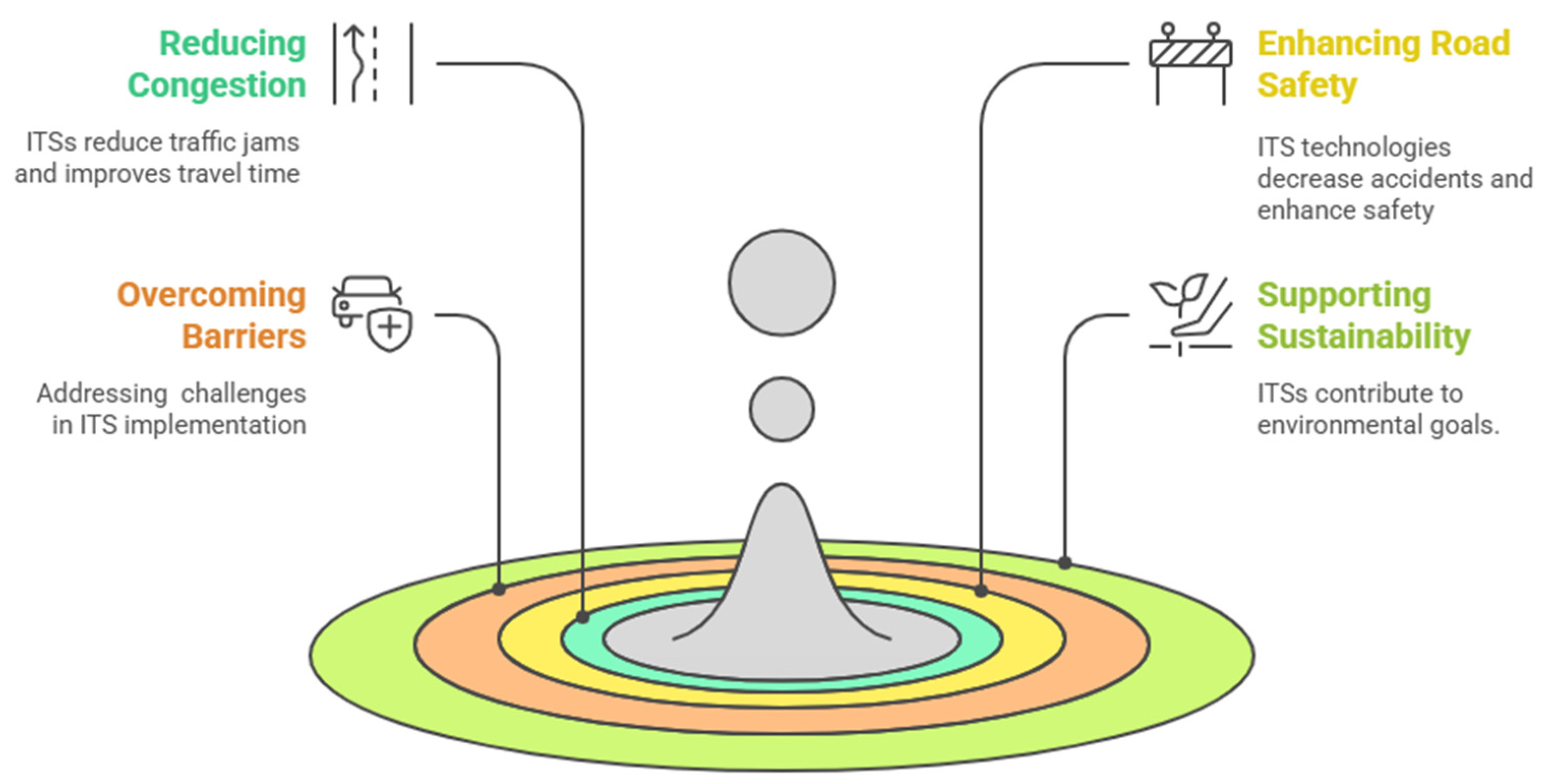
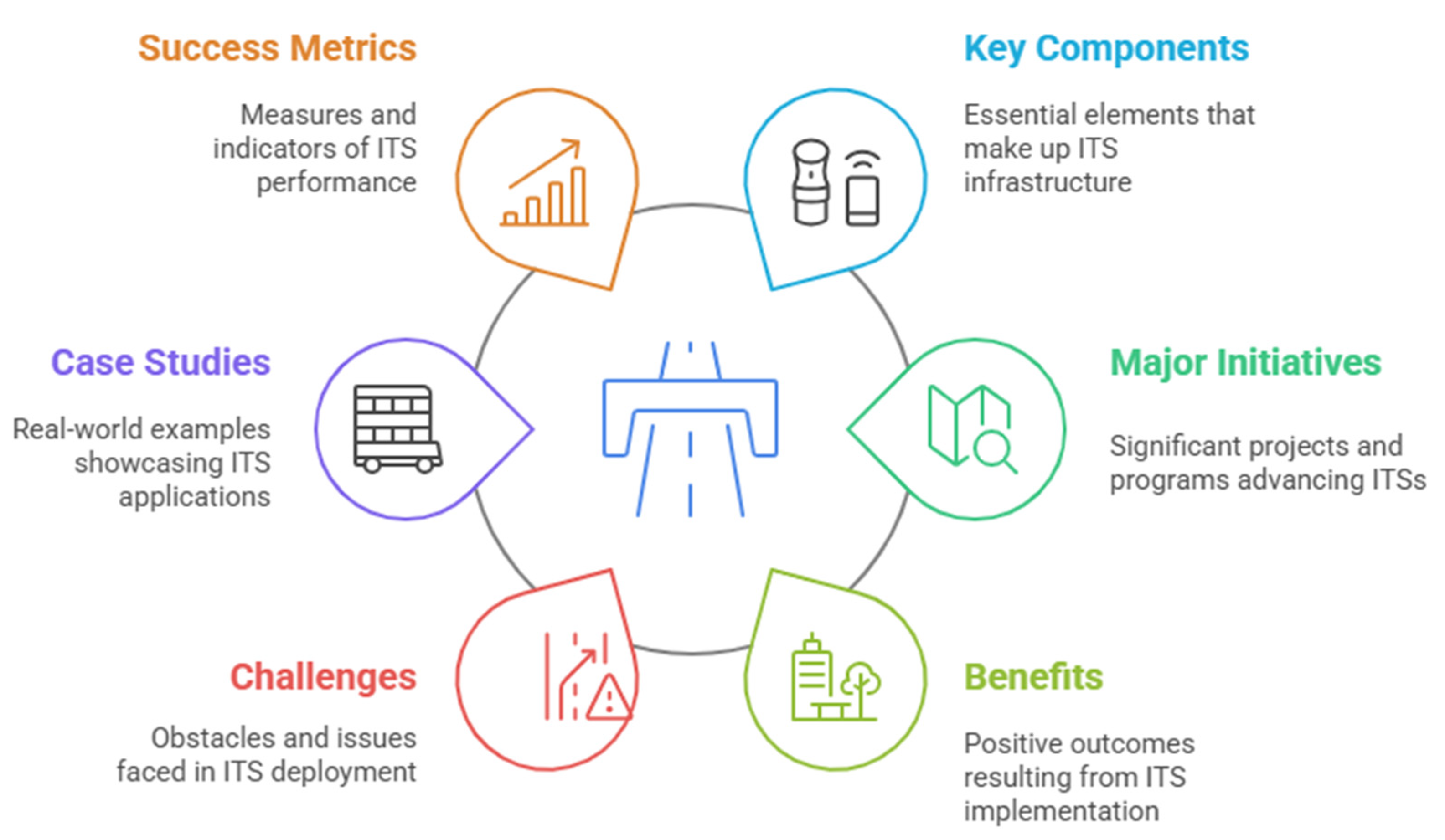
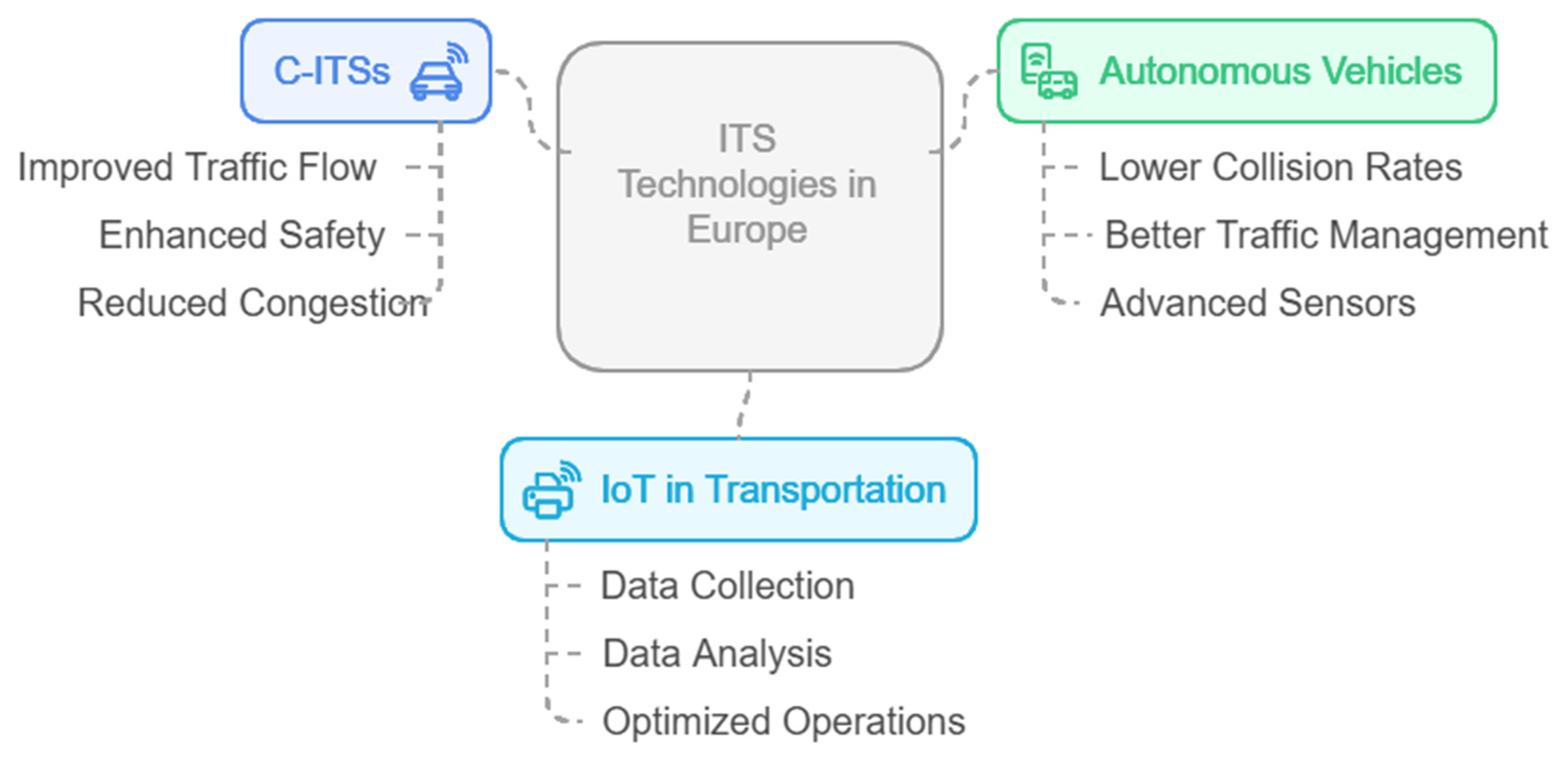
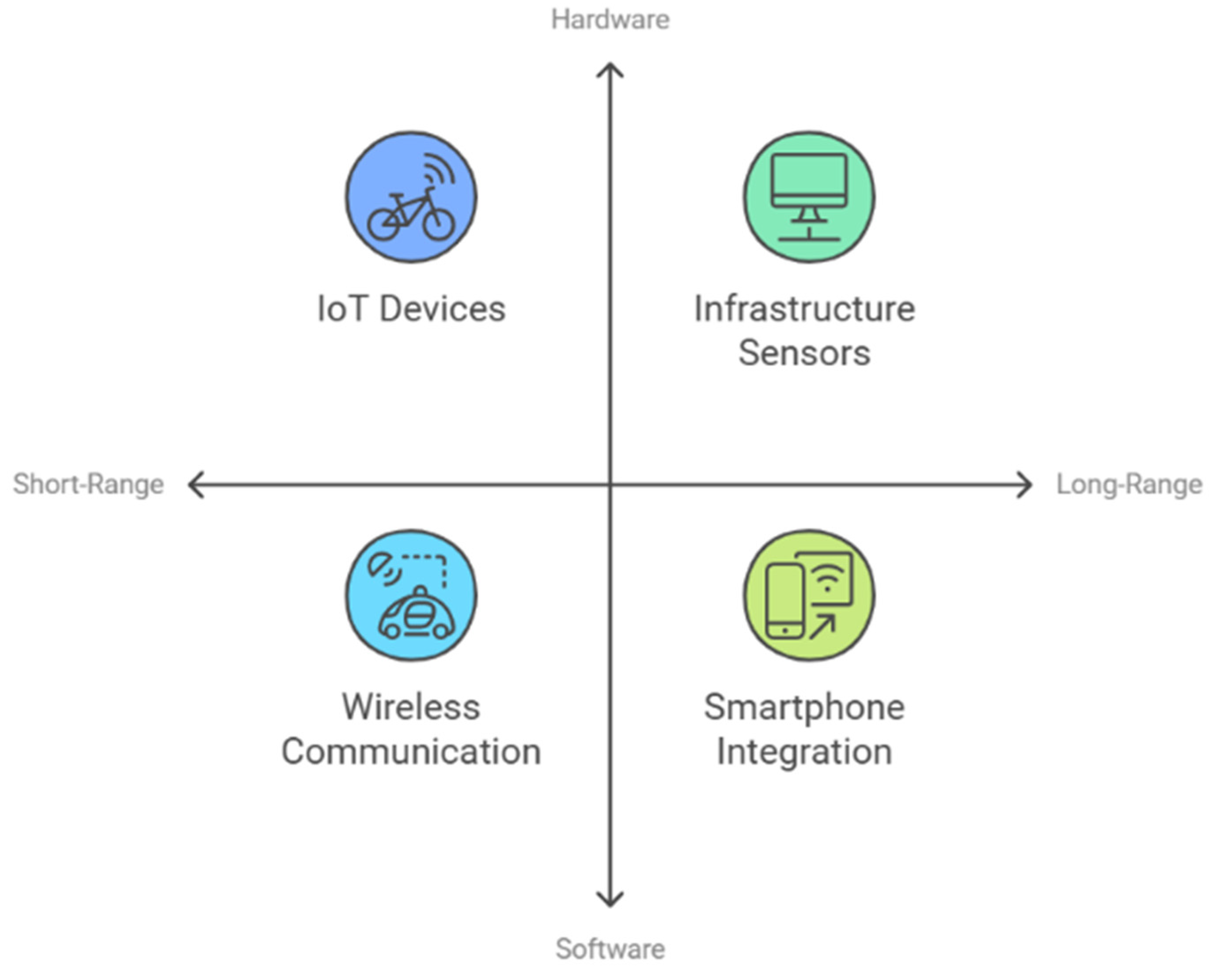
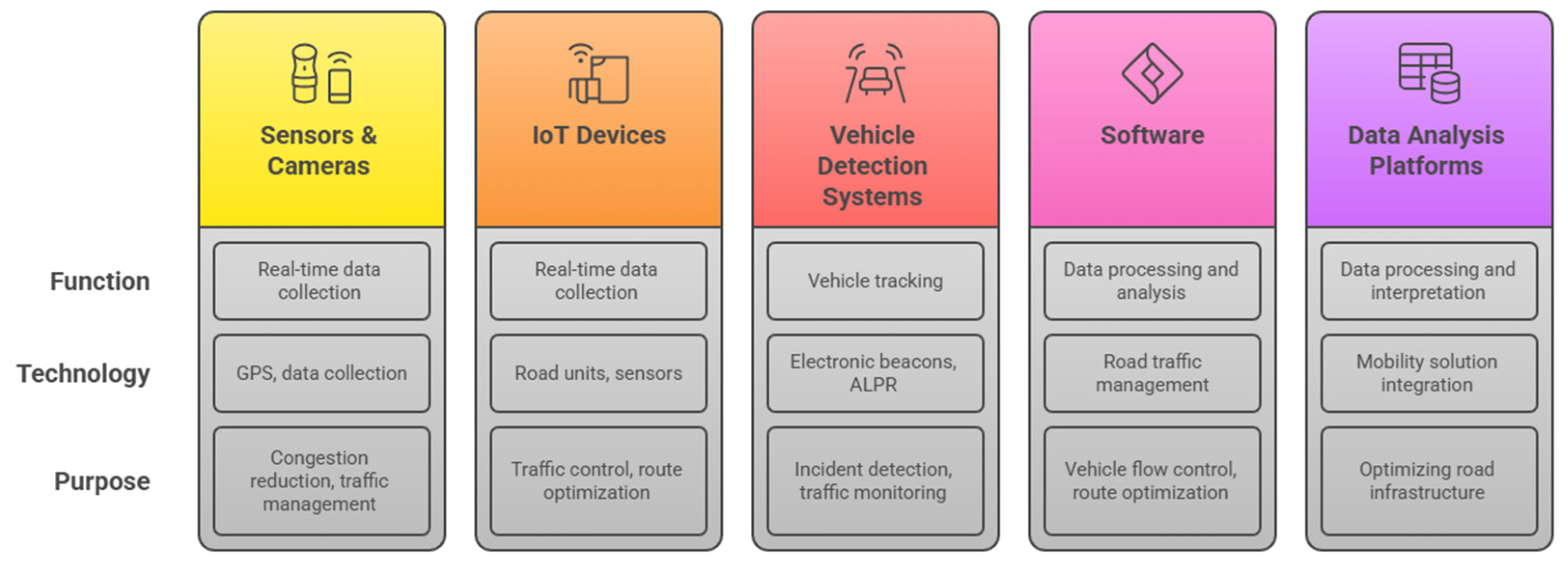
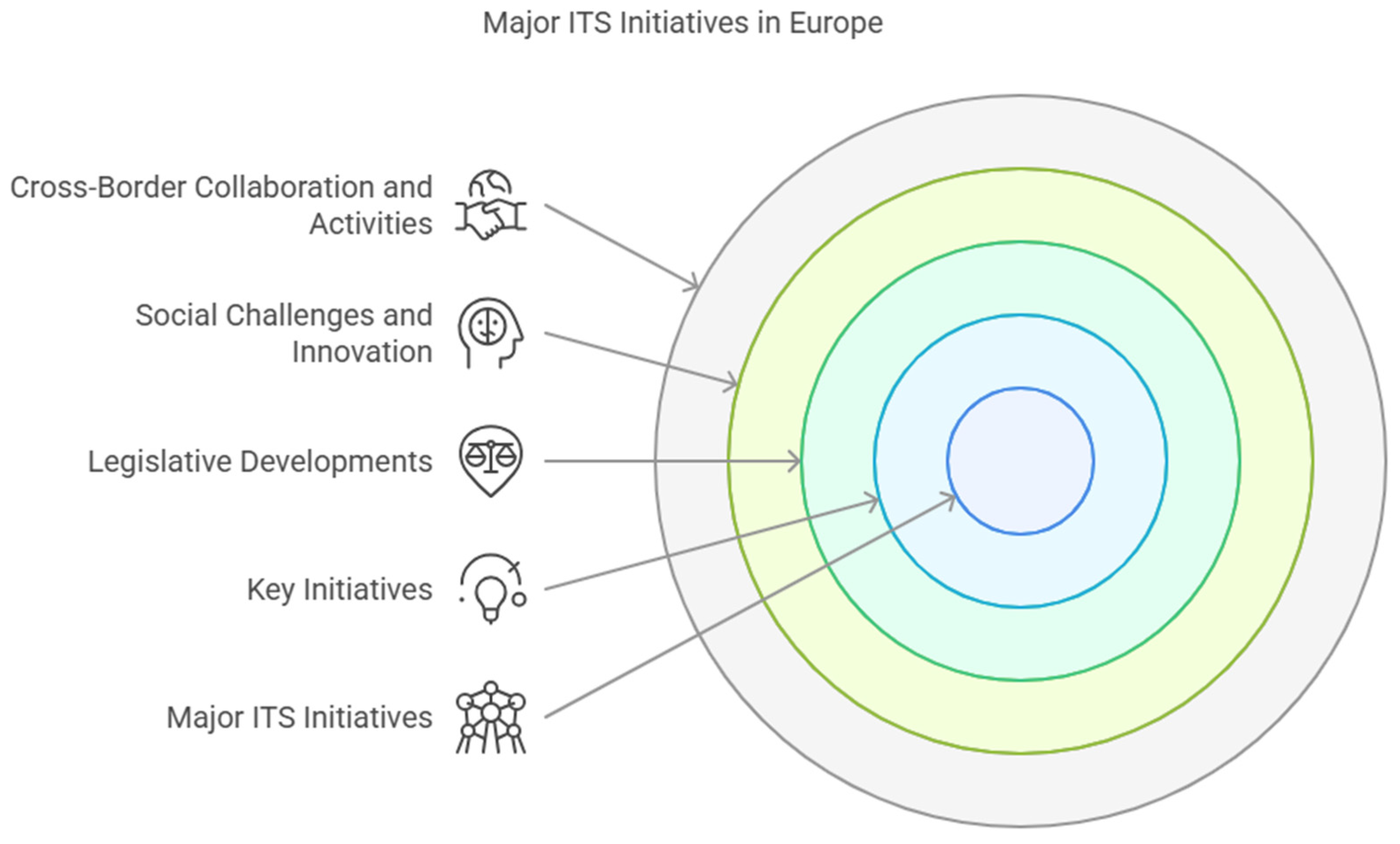


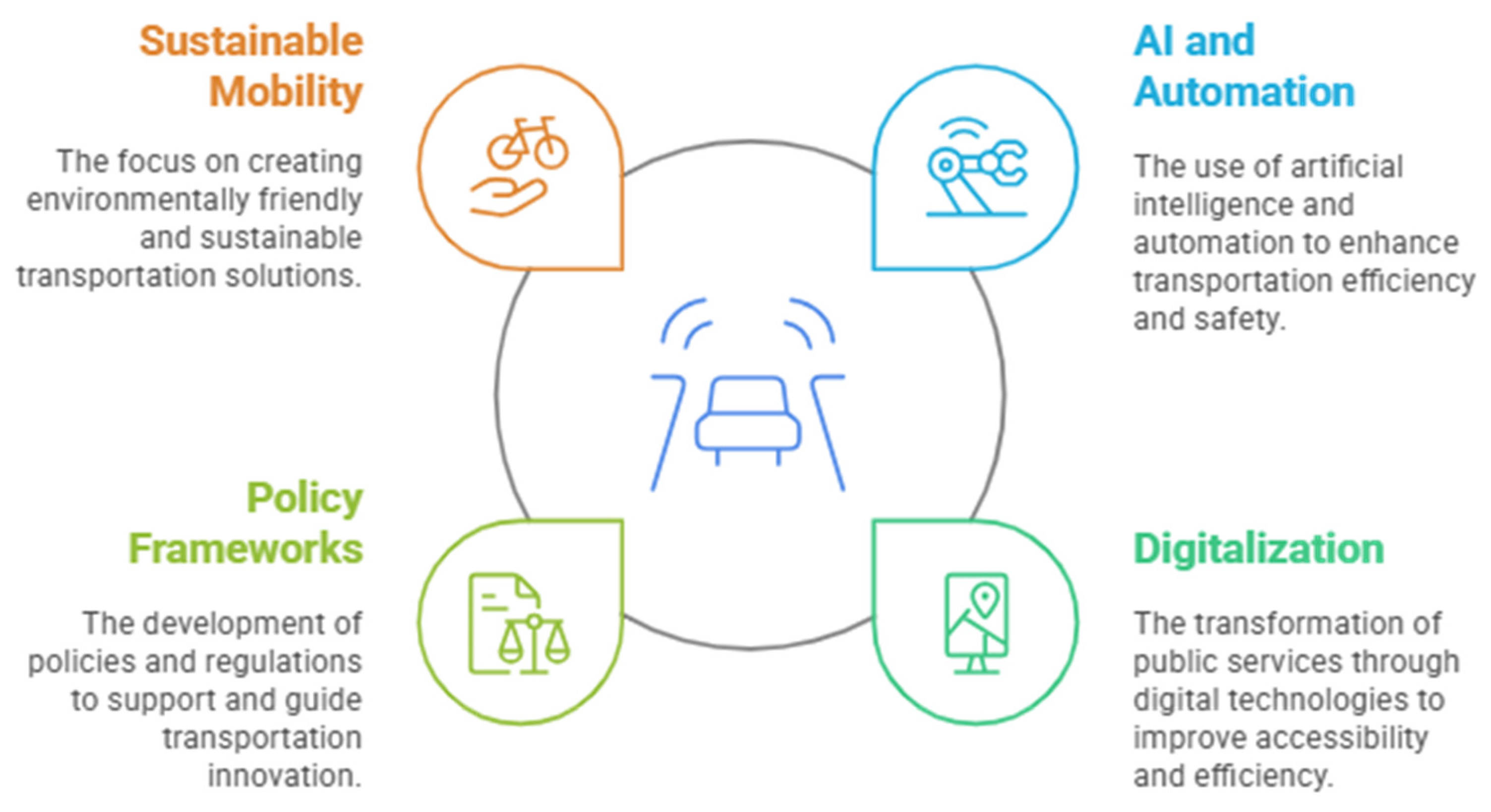
| City, Country | Year of Implementation | Type of ITS Implemented | Investment [Million EUR] | Results Achieved |
|---|---|---|---|---|
| Berlin, Germany [25] | 2021 | AI-based traffic management | 250 | 15% reduction in congestion |
| Paris, France [26] | 2022 | Smart parking systems | 180 | 30% improved parking efficiency |
| Madrid, Spain [27] | 2023 | Autonomous bus fleet | 200 | 20% reduction in commute time |
| Amsterdam, The Netherlands [28] | 2021 | Bicycle ITS integration | 150 | 25% increase in cycling trips |
| Vienna, Austria [29] | 2022 | Smart pedestrian crossings | 170 | 40% fewer pedestrian accidents |
| Milan, Italy [30] | 2023 | Real-time public transport tracking | 190 | 10% increase in public transport use |
| Stockholm, Sweden [31] | 2020 | 5G-enabled traffic signals | 220 | 20% reduction in travel delays |
| Helsinki, Finland [32] | 2021 | AI-powered congestion control | 230 | 18% lower CO2 emissions |
| Brussels, Belgium [33] | 2022 | V2I communication systems | 210 | Improved road safety by 25% |
| Lisbon, Portugal [34] | 2023 | Electric bus fleet expansion | 260 | 30% reduction in fuel costs |
| Copenhagen, Denmark [35] | 2021 | Smart tolling system | 240 | 10% increase in toll revenue |
| Prague, Czech Republic [36] | 2022 | AI-based transit scheduling | 200 | 15% improvement in bus punctuality |
| Budapest, Hungary [37] | 2023 | Intelligent intersection control | 180 | 12% decrease in traffic congestion |
| Warsaw, Poland [38] | 2021 | Smart highway system | 250 | 20% improved traffic flow |
| Bucharest, Romania [39] | 2022 | ITS-integrated metro system | 220 | 10% more metro users |
| Cluj-Napoca, Romania [40] | 2023 | Integrated smart transport systems (smart lights, e-ticketing, real-time info) | 160 | Enhanced urban efficiency and sustainability |
| Riga, Latvia [41] | 2023 | Electric tram modernization | 210 | 15% energy savings |
| Tallinn, Estonia [42] | 2021 | Real-time urban mobility apps | 190 | 20% improved transit efficiency |
| Vilnius, Lithuania [43] | 2022 | Smart pedestrian monitoring | 180 | 30% reduction in pedestrian accidents |
| Sofia, Bulgaria [44] | 2023 | Intelligent traffic cameras | 170 | 12% more effective law enforcement |
| Zagreb, Croatia [45] | 2021 | AI-based vehicle tracking | 160 | 10% reduction in transport delays |
Disclaimer/Publisher’s Note: The statements, opinions and data contained in all publications are solely those of the individual author(s) and contributor(s) and not of MDPI and/or the editor(s). MDPI and/or the editor(s) disclaim responsibility for any injury to people or property resulting from any ideas, methods, instructions or products referred to in the content. |
© 2025 by the authors. Published by MDPI on behalf of the World Electric Vehicle Association. Licensee MDPI, Basel, Switzerland. This article is an open access article distributed under the terms and conditions of the Creative Commons Attribution (CC BY) license (https://creativecommons.org/licenses/by/4.0/).
Share and Cite
Cordoș, N.; Duma, I.; Moldovanu, D.; Todoruț, A.; Barabás, I. An Overview of Intelligent Transportation Systems in Europe. World Electr. Veh. J. 2025, 16, 387. https://doi.org/10.3390/wevj16070387
Cordoș N, Duma I, Moldovanu D, Todoruț A, Barabás I. An Overview of Intelligent Transportation Systems in Europe. World Electric Vehicle Journal. 2025; 16(7):387. https://doi.org/10.3390/wevj16070387
Chicago/Turabian StyleCordoș, Nicolae, Irina Duma, Dan Moldovanu, Adrian Todoruț, and István Barabás. 2025. "An Overview of Intelligent Transportation Systems in Europe" World Electric Vehicle Journal 16, no. 7: 387. https://doi.org/10.3390/wevj16070387
APA StyleCordoș, N., Duma, I., Moldovanu, D., Todoruț, A., & Barabás, I. (2025). An Overview of Intelligent Transportation Systems in Europe. World Electric Vehicle Journal, 16(7), 387. https://doi.org/10.3390/wevj16070387










